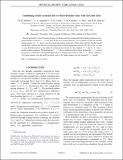| dc.contributor.author | Moulai, Marjon H. | |
| dc.contributor.author | Argüelles, C.A. | |
| dc.contributor.author | Collin, G. H. | |
| dc.contributor.author | Conrad, J.M. | |
| dc.contributor.author | Diaz, A. | |
| dc.contributor.author | Shaevitz, M. H. | |
| dc.date.accessioned | 2020-08-13T14:49:54Z | |
| dc.date.available | 2020-08-13T14:49:54Z | |
| dc.date.issued | 2020-03 | |
| dc.date.submitted | 2019-11 | |
| dc.identifier.issn | 2470-0029 | |
| dc.identifier.issn | 2470-0010 | |
| dc.identifier.uri | https://hdl.handle.net/1721.1/126558 | |
| dc.description.abstract | Recent global fits to short-baseline neutrino oscillation data have been performed finding preference for a sterile neutrino solution (3+1) over null. In the most recent iteration, it was pointed out that an unstable sterile neutrino (3+1+decay) may be a better description of the data. This is due to the fact that this model significantly reduces the tension between appearance and disappearance datasets. In this work, we add a 1-year IceCube dataset to the global fit obtaining new results for the standard 3+1 and 3+1+decay sterile neutrino scenarios. We find that the 3+1+decay model provides a better fit than the 3+1, even in the presence of IceCube, with reduced appearance to disappearance tension. The 3+1+decay model is a 5.4σ improvement over the null hypothesis and a 2.8σ improvement over the standard 3+1 model. | en_US |
| dc.description.sponsorship | NSF (Grant no. GRFP-1122374) | en_US |
| dc.description.sponsorship | NSF (Grant no. PHY-1707971) | en_US |
| dc.description.sponsorship | NSF (Grant no. PHY-1801996) | en_US |
| dc.publisher | American Physical Society | en_US |
| dc.relation.isversionof | 10.1103/PhysRevD.101.055020 | en_US |
| dc.rights | Creative Commons Attribution 3.0 unported license | en_US |
| dc.rights.uri | http://creativecommons.org/licenses/by/3.0 | en_US |
| dc.source | American Physical Society | en_US |
| dc.title | Combining sterile neutrino fits to short-baseline data with IceCube data | en_US |
| dc.type | Article | en_US |
| dc.identifier.citation | Moulai, M.H. et al. "Combining sterile neutrino fits to short-baseline data with IceCube data." Physical Review D 101 (March 2020): 055020 doi 10.1103/PhysRevD.101.055020 ©2020 Author(s) | en_US |
| dc.contributor.department | Massachusetts Institute of Technology. Department of Physics | en_US |
| dc.contributor.department | Massachusetts Institute of Technology. Institute for Data, Systems, and Society | en_US |
| dc.relation.journal | Physical Review D | en_US |
| dc.eprint.version | Final published version | en_US |
| dc.type.uri | http://purl.org/eprint/type/JournalArticle | en_US |
| eprint.status | http://purl.org/eprint/status/PeerReviewed | en_US |
| dc.date.updated | 2020-03-18T14:34:12Z | |
| dc.language.rfc3066 | en | |
| dspace.date.submission | 2020-03-18T14:34:11Z | |
| mit.journal.volume | 101 | en_US |
| mit.license | PUBLISHER_CC | |
| mit.metadata.status | Complete | |
